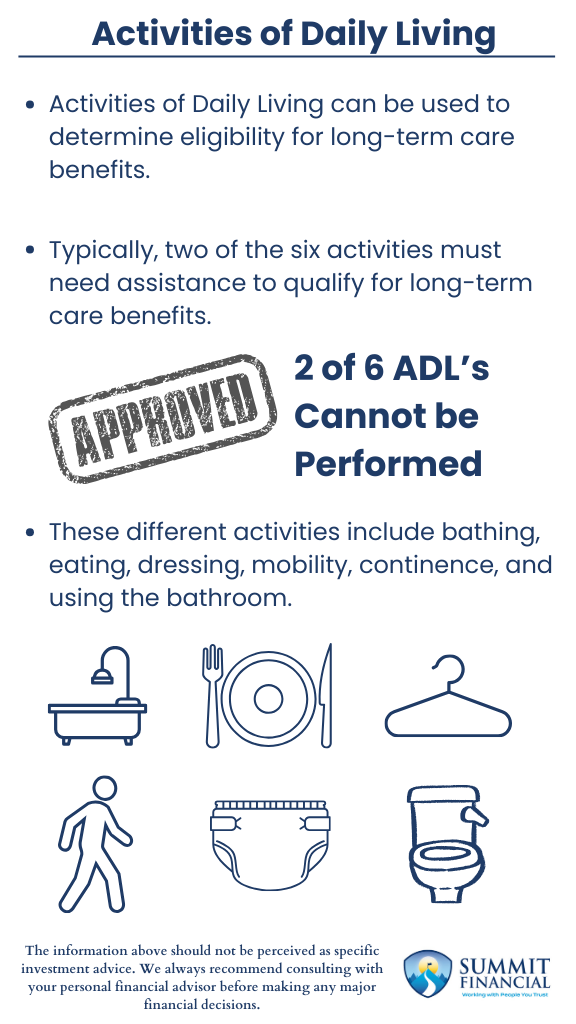In a previous post, we discussed the topic of long-term care planning and the options available to help cover potential long-term care expenses. In this post, we will focus on Activities of Daily Living (ADLs) and how they are used to determine eligibility for long-term care benefits.

Why These Activities Are Used to Determine Eligibility
Activities of Daily Living are used to determine eligibility for long-term care benefits since they are considered a gauge of whether someone needs a certain level of assistance.
Typically, two of the six activities must need assistance to qualify for benefits. The rationalization is that someone who is sick or disabled may be able to live their normal lives while needing assistance with zero or even one activity, but two is to the extent that it would disrupt their daily life.
Reviewing the Six Activities
The first activity on our list, which may come to mind quickly when thinking of a long-term care need, is eating.
-
If someone cannot feed themselves then they require daily assistance.
-
This would include preparing meals as well as consuming them.
Another potentially quick-to-mind activity is bathing.
-
This may be one of the more intensive activities since getting in and out of the shower/bathtub can be difficult for many individuals.
-
The slipping hazard caused by water can be dangerous and efficient bathing may require an extensive range of motion as well.
Mobility and Dressing: Similar but Distinct
Next on our list is mobility.
-
This can be defined as sitting, standing, walking, or moving around the home in general.
This is separate from dressing, which is used when someone needs help changing clothes or getting dressed.
-
These are very similar activities, but they each define specific movements.
-
Getting dressed includes more precise movement as well as more mental activity as the thought process behind choosing clothes is more involved than just moving around the home.
Lastly, the final two activities could be paired together. Continence refers to the ability to control your bladder or bowel movements. Then toileting or using the bathroom is the final activity.
Continence and Toileting
Lastly, the final two activities could be paired together.
-
Continence refers to the ability to control your bladder or bowel movements.
-
Toileting or using the bathroom is the final activity.
So, these activities are separated into the internally controlled activity of continence and the physical task of using the bathroom.
Someone may be able to control their bowels but may not easily be able to get on and off the toilet, while someone else may be able to physically use the toilet but struggles with getting to the toilet in time due to lack of control.
Navigating the Gray Areas in ADL Assessment
The activities discussed above may not always be a black and white line for whether the activity can be performed.
It can be a gray zone where someone can:
-
Perform the activity with a modification to their home
-
Rely on specific medication
-
Perform the activity sometimes but not always
Due to the lack of clarity at times, most long-term care benefits require a doctor to sign off on the inability for performing two of six activities.
Once approved, since it is possible to regain the ability to perform an activity, annual reconfirmations are necessary to ensure the individual still cannot perform the activities.
Activities of Daily Living – Highlights
- Activities of Daily Living can be used to determine eligibility for long-term care benefits.
- Typically, two of the six activities must need assistance to qualify for long-term care benefits.
- These different activities include bathing, eating, dressing, mobility, continence, and using the bathroom.
Speak With a Trusted Advisor
If you have any questions about ADLs, your investment portfolio, taxes, retirement planning, our 401(k)-recommendation service, or anything else in general, please call our office at (586) 226-2100. Please also reach out if you have had any changes to your income, job, family, health insurance, risk tolerance, or overall financial situation.
Feel free to forward this commentary to a friend, family member, or co-worker. We hope you learned something today. If you have any feedback or suggestions, we would love to hear them
Best Regards,
Zachary A. Bachner, CFP®
with contributions from Robert Wink, Kenneth Wink, and James Wink.
If you found this article helpful, consider reading:
Sources:


